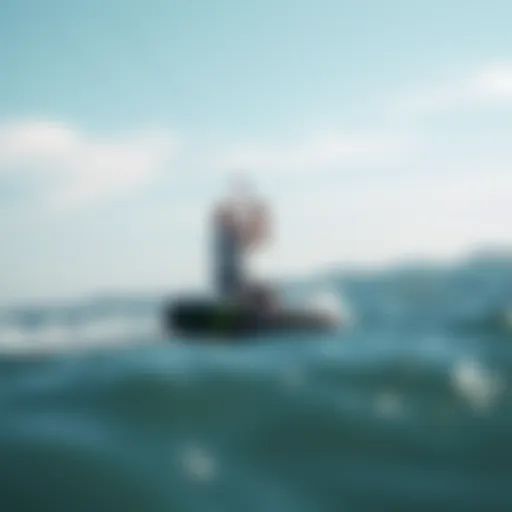Exploring the Benefits of Carbon Boards in Kiteboarding


Intro
Kiteboarding has rapidly gained traction among adventure lovers and thrill-seekers, embodying a unique intersection of surfing and flying. Among the various factors that influence performance in this high-octane sport, the type of board used can make all the difference. This brings us to an increasingly popular option in the kiteboarding community: carbon boards. Known for their advanced material properties and performance capabilities, these boards are becoming a staple for both newbies and seasoned pros.
Understanding carbon boards is not just a matter of being up-to-date with equipment trends; it's about recognizing how they can enhance one's riding experience, adapt to different conditions, and how to care for these specialized tools. Let’s set the stage to discuss the gear and equipment, including essential insights to keep everyone, from novice kiteboarders to the more experienced, in the loop.
Intro to Carbon Boards
The world of kiteboarding is always evolving, and a significant hallmark of this evolution is the rise of carbon boards. These aren’t just a new trend; they symbolize the merging of creativity and science in sports equipment. Understanding carbon boards is essential for anyone keen on getting the most out of their kiteboarding experience. Aboard these sleek, lightweight marvels, riders can experience amplified performance that translates to sharper turns, more speed, and heightened control.
In this article, we will break down the essence of carbon boards, covering their construction, material makeup, and the advantages they offer. By highlighting the benefits and potential drawbacks, it sets a stage for discussions both seasoned kiteboarders and novices can benefit from. It is crucial to grasp how these boards perform across various kiteboarding environments. Moreover, for those looking to invest wisely in their gear, knowing the history and evolution of board materials will inform better choices when selecting the perfect fit for their skill level and riding style.
Defining Carbon Boards
A carbon board in kiteboarding is not just a board; it's a sophisticated piece of engineering primarily constructed from carbon fiber. Carbon fiber's low weight and high tensile strength make it an ideal material for boards, providing both durability and agility. These boards can be easily distinguished by their distinct fiber pattern and often sleek, polished finish. They boast a design that emphasizes efficiency; each curve and angle are tailored to reduce drag and enhance lift, allowing riders to harness the wind's power more effectively. Unlike traditional materials such as fiberglass and wood, carbon fiber delivers a unique set of characteristics that lend to an exhilarating ride.
History of Board Material Evolution
When one thinks of kiteboarding, the underlying materials of the equipment often go unnoticed, but they are foundational to the sport's progression. Initially, boards were fashioned from solid wood or plywood, which provided good enough durability but fell short in weight efficiency and performance. As kiteboarding gained traction in the late 1990s, enthusiasts began experimenting with different materials, such as fiberglass and epoxy resins, which marked a significant leap in construction technology.
The introduction of composite materials saw a seismic shift. Board manufacturers started blending fiberglass with lighter core materials for an enhanced user experience. However, the game changed entirely with the emergence of carbon fiber in the early 2000s. This material revolution offered significant improvements in strength-to-weight ratios.
Riders quickly recognized the benefits; boards became lighter and more responsive, yielding dynamic performance both in lighter breezes and under heavy load. The importance of these innovations can’t be overstated; they made kiteboarding more accessible and enjoyable across various skill levels. Recognizing how materials shaped this sport is fundamental to appreciating the full potential of carbon boards today.
Material Science Behind Carbon Boards
The exploration into the material science of carbon boards serves as a pivotal component of this discussion. Kiteboarders, whether novices or seasoned pros, need to understand how the qualities of carbon fiber can enhance their overall experience on the water. Knowledge of this area not only lays a strong foundation for choosing the right equipment but also highlights the advancements in technology that contribute to performance excellence.
Properties of Carbon Fiber
Carbon fiber is renowned for its superior strength-to-weight ratio and stiffness. These characteristics make it an ideal material for kiteboarding, as they allow for faster speeds and more agile maneuvers, traits every rider seeks for an edge over the competition. The material's lightweight nature means that riders can execute jumps and tricks with greater ease and less physical strain.
Moreover, carbon fiber has excellent resistance to fatigue. Unlike some materials that may weaken over time with repeated stress, carbon boards maintain their integrity, providing a reliable experience across many rides. To put things in perspective:
- Strength: Carbon fiber can be up to five times stronger than steel, while remaining much lighter.
- Durability: It withstands impact better than traditional materials, reducing the risk of dings and dents.
- Flexibility: It offers a level of controlled flex that can enhance ride comfort and performance.
"Understanding these properties can bring riders closer to achieving their personal best in kiteboarding."
Manufacturing Process
The crafting of carbon boards is a detailed and intricate process that reflects the material's advanced properties. Typically, it involves layers of carbon fiber fabric saturated with resin, an approach that ensures a strong bond and desired board characteristics.
- Preparation: The process starts with preparing the mold, which shapes the board. Precision in this step ensures consistency in performance.
- Layup: Carbon fiber layers are laid up in a specific direction to optimize strength and flexibility, often alternating layers to enhance performance characteristics.
- Resin infusion: A resin is infused into the fibers, providing strength and cohesion. The choice of resin can significantly influence durability and weight.
- Curing: The board is cured under heat and pressure. This stage solidifies the construction, enhancing the board's rigidity and responsiveness.
The entire manufacturing cycle is vital to the end product's performance. Understanding these stages provides insight into the craftsmanship behind carbon boards and the attention to detail that goes into producing a high-quality piece of equipment.
Comparison with Other Materials
When looking at kiteboarding, comparing carbon fiber boards to alternatives such as plywood or plastic reveals significant differences that influence rider choice.
- Weight: Carbon boards are significantly lighter than their wooden or plastic counterparts, allowing for quicker transitions and easier handling.
- Longevity: While materials like wood are cheaper, they can deteriorate faster, especially when subjected to water and moisture. In contrast, carbon boards resist aging and wear effectively.
- Performance: Riders often notice a stark difference in response rates. Carbon boards can be engineered to respond to inputs with precision, while less advanced materials may lag or feel dull underfoot.
This distinction becomes crucial for riders looking for that extra edge in performance. Investing in a carbon board frequently translates to enhanced experiences and greater longevity in the equipment, justifying the initial cost for serious enthusiasts.
Performance Characteristics of Carbon Boards
When it comes to kiteboarding, the performance characteristics of the gear can make or break your ride. Carbon boards have some distinct features that set them apart from other materials, playing a critical role in their overall performance. Understanding these characteristics is essential for riders of all skill levels who want to maximize their experience on the water.
Weight-to-Strength Ratio
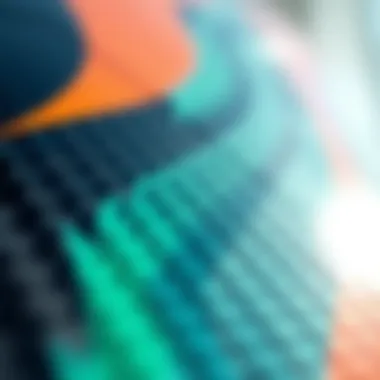
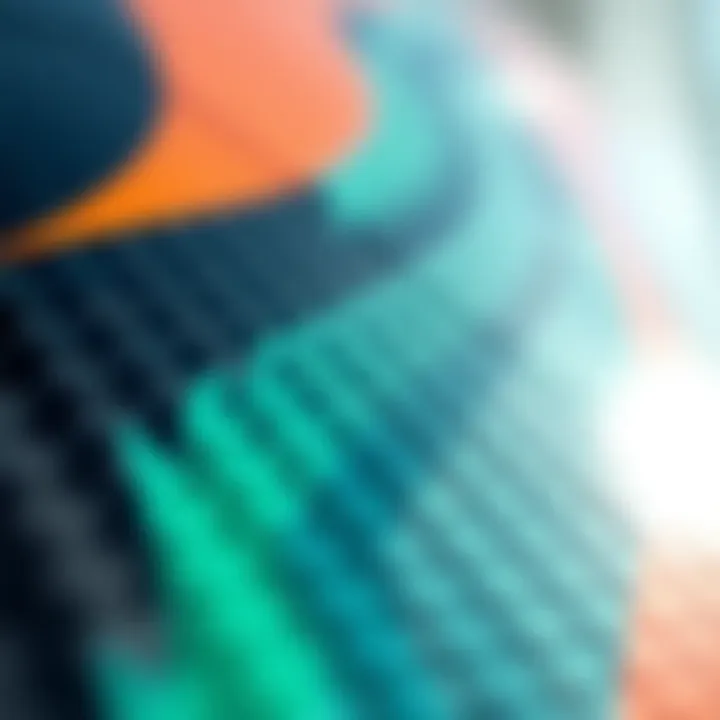
One of the most impressive attributes of carbon boards is their extraordinary weight-to-strength ratio. This means that for their lightweight design, they offer tremendous strength and durability. This ratio is essential for kiteboarders, as a lighter board makes it easier to maneuver and boosts speed, while sturdiness ensures the board can withstand the stresses of intense riding. A well-constructed carbon board can weigh up to 30% less than traditional fiberglass boards, which can significantly affect a rider's agility on the water.
"The lighter the board, the snappier the response!"
When discussing the weight-to-strength ratio, it’s worthwhile to note that the composition of the carbon can differ between manufacturers. Some boards use unidirectional carbon, while others mix it with other fibers. This blend can affect the overall performance, making it vital for riders to consider their personal preferences before making a purchase.
Flex and Responsiveness
Another characteristic where carbon boards shine is their flex and responsiveness. A well-designed carbon board can deliver an exhilarating ride due to its ability to flex under pressure. This results in a lively sensation that translates power from the kite into the water seamlessly.
A sonorous board doesn’t only feel nice; it aids in maintaining control and stability while gliding over waves. Many riders appreciate how carbon boards react to shifts in weight, allowing for quick pivots and sharp turns without sacrificing performance. However, it is also crucial to find a balance; too much stiffness may dampen responsiveness, while excessive flex diminishes speed. Each rider needs to reflect on their style and what feels comfortable underneath their feet, for those subtle changes can impact performance drastically.
Overall Handling in Various Conditions
Kiteboarding conditions can be unpredictable, and the ability of a board to adapt is vital. Carbon boards generally excel in overall handling across different environments. Whether it's light winds, choppy waters, or strong gusts, a good carbon board holds its ground.
In light winds, carbon boards can be designed to get up on a plane easily, enhancing ride enjoyment even when conditions aren’t ideal. On the other side, during stronger winds, many riders find that the rigidity of carbon can be a double-edged sword. It leads to stable control in turbulence, but riders need to ensure their technique accounts for that power, or they may find themselves overpowered. Likewise, when dealing with choppy waters, carbon boards maintain stability while cutting through the surface, providing a comfortable ride that retrieves speed quickly.
All in all, the performance characteristics of carbon boards culminate in creating a tool for kiteboarders that not only looks impressive but also facilitates joy, speed, and agility on the water. Understanding these nuances allows riders to make informed decisions based on their skill levels and the challenges they anticipate facing.
Advantages of Using Carbon Boards
The appeal of carbon boards in kiteboarding can’t be overstated. These boards bring a combination of performance gains and unique benefits that can shape the way riders experience the sport. For enthusiasts and competitors alike, understanding the advantages is fundamental to making an informed choice. Let’s dive into what makes these boards stand out in the crowded field of kiteboarding equipment.
Increased Speed and Performance
When it comes to kiteboarding, speed often translates to more thrill and better performance. Carbon boards are known for their lightweight properties, which allows for sharper acceleration. Unlike traditional materials, carbon fiber has a high strength-to-weight ratio, enhancing a rider's ability to catch air and maintain momentum. The stiffer nature of these boards can ultimately translate to quicker edge-to-edge response, ideal for executing advanced maneuvers. The result is a performance upgrade that serious riders seek
“Many kiteboarders find they can perform better in competitions simply by upgrading to a carbon board,” said Emily, a local kitesurfing instructor.
Furthermore, the controlled flex in carbon boards allows for better responsiveness to rider inputs. This means that your every subtle shift in weight can result in a more precise aerial maneuver or carving turn, elevating not only performance but also the enjoyment factor.
Durability and Longevity
Durability is crucial for any athlete considering equipment investment. Carbon boards excel here, offering strength that rivals even some of the toughest materials used in sports gear. They hold up well against impacts and abrasions that typically plague other boards, effectively shrugging off minor dings from rocks or other debris in the water.
The lifespan of these boards, when cared for correctly, can far exceed those made of materials like wood or plastic. Many seasoned riders report that their carbon boards have remained intact for years, allowing for continued high performance without the need for frequent replacements. This brings not only potential cost savings over time but also confidence in equipment reliability during intense sessions.
Efficient Energy Transfer
Energy transfer refers to how well the board takes the energy produced by the kite and translates it into forward motion or height. Carbon boards provide exceptional energy transfer, thanks to their rigid structure. When a kite pulls, a carbon board efficiently converts that force into speed, allowing riders to accelerate quickly, jump higher, and perform more complex tricks with less effort.
This efficiency can be a game-changer, especially during longer sessions where fatigue might set in. The reduced energy loss means that riders can focus on their technique rather than battling their equipment, making the sport more accessible regardless of skill level.
In summary, the advantages of using carbon boards in kiteboarding are clear. They can increase speed, boost durability, and improve energy efficiency, offering riders an opportunity to elevate their experience on the water. For those looking at the fine details of their equipment choices, carbon boards stand out as a prime investment.
Considerations When Choosing a Carbon Board
Choosing a carbon board for kiteboarding is no small feat. The decision factors into not just the board's functionality but also your personal experience and aspirations in the sport. A well-chosen board can dramatically enhance your ride, while a misjudged selection might leave you adrift, struggling against the elements.
Skill Level and Experience
Understanding your skill level is key when selecting a carbon board. If you’re just taking your first strides on the water, a more forgiving board might be the ticket. These boards provide ease of use and stability. For example, a wider board can help novice riders find their footing.
Conversely, for those whose skill sets have blossomed into something more advanced, a performance-oriented carbon board could look like a silk purse waiting to be unleashed. These boards tend to be lighter and possess enhanced responsiveness. Imagine slicing through the wind with precision. A pro-level board can propel you to perform daring tricks and boost your overall performance. It allows you to harness the wind’s power gracefully.
Keep this point in mind: your choice should resonate with where you stand on the skill ladder but also consider the heights you wish to reach.
Board Size and Design
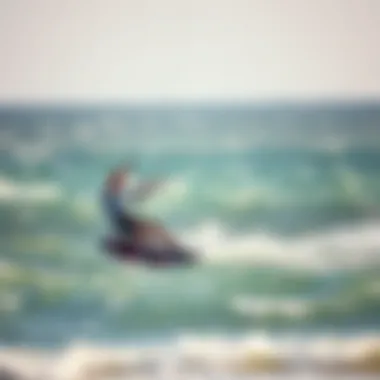
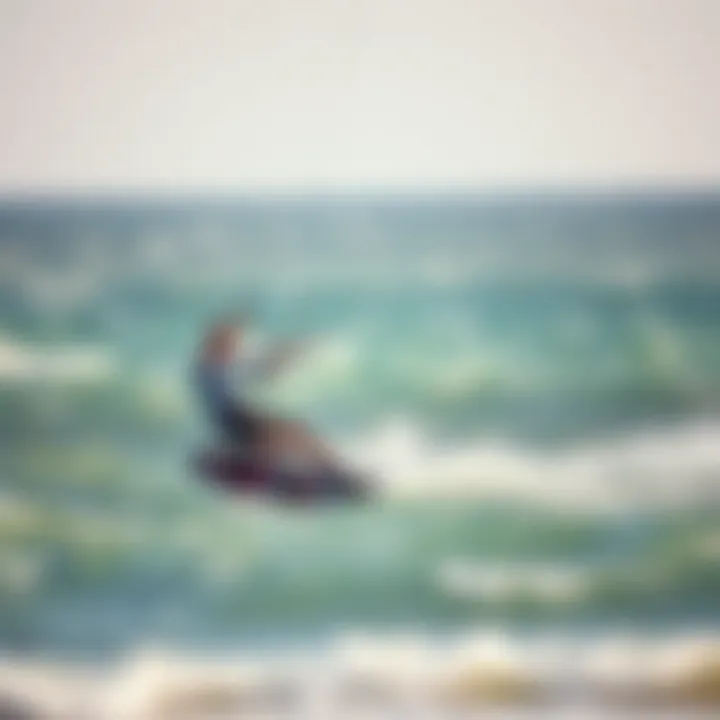
Size and design, they matter more than one might think. The dimensions of your chosen board deeply affect your riding experience. A longer board may offer better tracking and stability, ideal when you're venturing into choppy water. On the flip side, a shorter board gives a livelier feeling, making those aerial maneuvers easier to accomplish. It’s almost like choosing between cruising and dancing on water.
Additionally, the design influences performance. Carbon boards often come in various shapes tailored for different conditions. Consider a board designed for freestyle versus one made for wave riding. The rocker, or the curvature of the board, plays a large part in how it handles in various kiteboarding scenarios. A board with more rocker can ease landings, while a flatter board grants greater speed on plain water. Knowing what you'll be up against helps you pick the right design to match.
Cost vs. Value Analysis
When looking at carbon boards, it’s easy to get caught up in the allure of the latest models and the shiny price tags that often accompany them. A high-priced carbon board might have cutting-edge design features, but it's essential to analyze what's worth your hard-earned cash.
In this sporty world, more expensive doesn’t automatically equate to better. A thoughtful consideration of cost versus value often leads to deeper reflections on what you truly need.
- Budget Options: For someone starting out or looking for a secondary board, mid-range options could meet your needs without draining your wallet.
- Investment Boards: For seasoned riders willing to invest in their gear, spending more on a high-quality board can be seen as a long-term gain. Given the durability and enhanced performance carbon boards present, you might find they pay for themselves over time through better experiences.
Ultimately, weigh your options. Dive deep into researching your desired board's features and market prices. Always remember that a thoughtful investment can elevate not just your performance but also your enjoyment out on the water.
Whether you’re a fresh face in the kiteboarding scene or a wind-surfing veteran, ensuring your board fits your skillset and sailing conditions is paramount for an enjoyable ride.
For more information on kiteboarding, check out the following resources:
Carbon Boards in Varying Kiteboarding Conditions
Kiteboarding is known for its versatility, allowing riders to navigate a spectrum of conditions from calm lagoons to raging seas. One of the primary facets that determine the performance of kiteboarding gear is the board itself, especially when considering carbon boards. The unique characteristics of these boards make them suitable for varying kiteboarding conditions, ultimately affecting both the rider's experience and skill development. From tackling light winds to choppy waters, understanding the subtleties of carbon board performance in these scenarios can greatly enhance a rider's capability and enjoyment.
Performance in Light Winds
In light wind conditions, having the right board can mean the difference between soaring through the air and watching other riders take off. Carbon boards, with their lightweight nature, tend to perform remarkably well under these circumstances. The low drag design allows for an effortless glide, making it easier to gain speed and traction, which is essential when the wind isn’t strong enough to propel the rider efficiently.
Riders often find that the responsiveness of carbon boards enhances their ability to catch the slightest breeze. Aboard a carbon board, one can engage in a variety of maneuvers, building confidence and skill without the frustration that often accompanies heavier boards. In this way, carbon boards in light winds facilitate a more enjoyable and educational experience, allowing for progression even in less than optimal conditions.
Behavior in Strong Winds
When the winds start howling and conditions become tumultuous, the benefits of carbon boards can truly shine. Strong winds demand a board that can handle the force without compromising control. Carbon fiber, known for its high tensile strength, offers remarkable stiffness, which helps maintain stability in gusty conditions. This stiffness directly translates to precise handling, allowing riders to execute sharp turns and maintain a firm grip on their movements.
Moreover, in strong wind scenarios, the energy transfer of a carbon board is optimized. As a rider carves through the water, the board's ability to translate power effectively means riders can capitalize on their speed without getting tossed around by the turbulent water.
"Carbon boards often become the favored choice when tackling turbulent winds. Their construction supports not just speed but also dynamic response, helping users stay in control in the roughest conditions."
Adaptability to Choppy Waters
Choppy waters can present challenges that test both the skill of the rider and the capabilities of their equipment. Carbon boards exhibit a certain adaptability that allows riders to navigate these conditions with ease. Their design minimizes drag and allows for easier maneuverability, which is critical when water is bouncing beneath.
When riding over choppy waves, the lightweight feature of carbon boards helps riders maintain momentum while reducing fatigue, something heavier boards cannot accomplish as effectively. Moreover, the enhanced flex properties of carbon means that boards can absorb some of the impact from smaller waves without compromising the rider's speed. This essentially allows for a smoother ride, reducing the likelihood of being jarred off-course by unexpected bumps.
In summary, carbon boards are tailored to perform in a variety of kiteboarding conditions. Their lightweight and sturdy nature facilitates improved performance in light winds, stability in strong gusts, and adaptability through choppy waters, making them an invaluable asset for any serious kiteboarder. By recognizing these performance characteristics, riders can make informed decisions that significantly elevate their kiteboarding adventures.
Maintenance and Care for Carbon Boards
Maintaining a carbon board in kiteboarding is not just about keeping it looking good; it is crucial for performance and longevity. Regular care can make the difference between a board that lasts several seasons and one that succumbs to wear and tear quicker than you'd hoped. Remember, a carbon board is a significant investment—treat it right and it'll reward you with great performance on the water.
Routine Inspection
Periodic checks are essential in keeping your carbon board in top condition. A simple visual inspection before and after each session can catch minor issues before they become major headaches. Look for any cracks or chips on the surface. These might be small but can significantly affect performance and lead to more severe damage over time.
- Check the edges: Dings or chips can lower the board’s aerodynamics, leading to drag.
- Inspect the foot pads and straps: Ensure they are secure and free of wear. Loose straps can lead to accidents or limit your control.
- Look for signs of delamination: If the upper layer of the board is separating from the core, you need to address it immediately.
Keeping an eye on these elements not only enhances your riding experience but also extends the lifespan of your board.
Cleaning Techniques
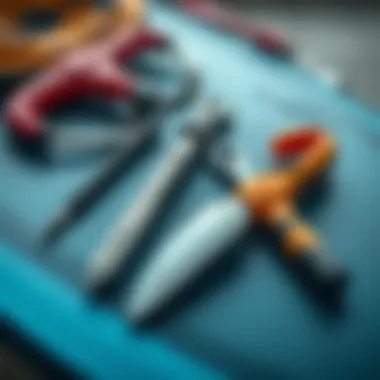
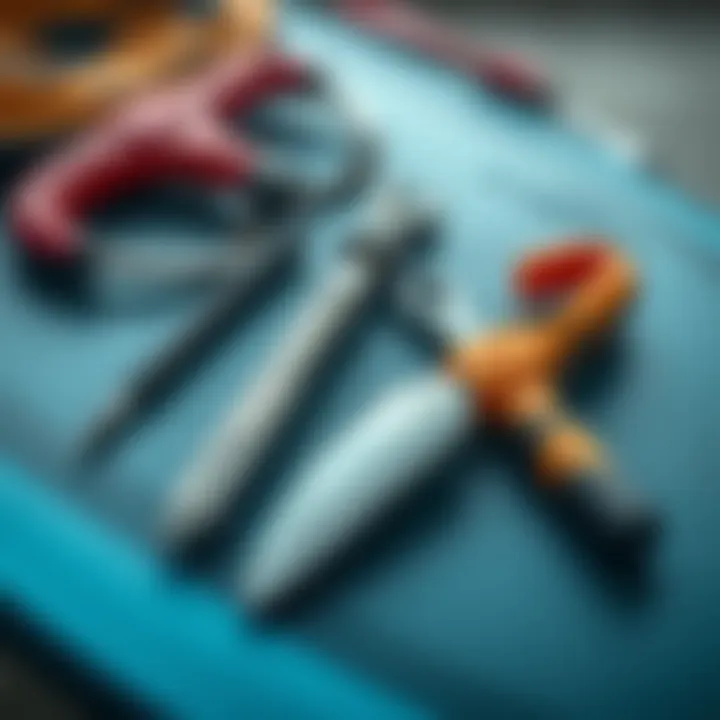
After a day of kiteboarding, it’s good practice to clean your carbon board. Saltwater, sand, and mud can all cause unseen damage if left on the surface too long. Here's how to keep your board clean and happy:
- Rinse off with fresh water: This step helps remove salt and debris which can cause corrosion over time.
- Use a soft sponge: Avoid abrasives, as they can scratch the surface of the board. Gently wipe it down to tackle any stubborn grime.
- Dry it properly: After rinsing, don’t just toss it aside. Wipe it dry to prevent water spots and to ensure it’s ready for the next use.
Some kiteboarders recommend special cleaning solutions, but typically, cold or lukewarm water does the job just fine.
Storage Recommendations
Proper storage is vital to keeping a carbon board in excellent condition. Store it away from direct sunlight and extreme temperatures. Here are a few tips for storing your board:
- Vertical storage: If possible, store your board upright. This prevents warping and ensures the integrity of the shape.
- Temperature control: Keep the board in a dry, climate-controlled environment. Extreme heat or cold can adversely affect the materials.
- Avoid stacking with other heavy items: This can cause pressure points, leading to dents and deformation.
As a rough-and-tumble sport, kiteboarding can put a lot on your gear. So, treating your board with the same respect it gives you on the water goes a long way in preserving its performance and effectiveness.
Remember: Taking a few minutes after each session to inspect, clean, and properly store your board can prevent costly repairs down the line.
In summary, maintenance and care for carbon boards are simply smart practices for enthusiasts who want to get the most out of their gear. With a little effort, your board will continue to deliver exhilarating rides for years to come.
The Future of Carbon Boards in Kiteboarding
As the sport of kiteboarding continues to evolve, so too does the technology behind the equipment, particularly the boards. Carbon boards have carved a niche for themselves in this realm due to their exceptional performance characteristics, yet the future promises even more advancements. The significance of the future of carbon boards lies in their potential to enhance the kiteboarding experience, not just for seasoned pros but also for newcomers to the sport. Each stride forward will open up new opportunities for innovation and transformation. Therefore, understanding these future trends is paramount for anyone interested in the dynamics of kiteboarding.
Innovative Technologies on the Horizon
Looking down the line, several technologies are on the cusp of revolutionizing carbon boards. Manufacturers are always on the hunt to integrate new materials and manufacturing processes that could yield even better performance metrics.
- 3D Printing: One potential game-changer is the use of 3D printing in board construction. This method can allow for customized designs tailored to specific rider preferences, which adds a personal touch and optimizes performance based on individual style.
- Smart Board Tech: Another exciting advancement involves the incorporation of sensors that can provide real-time feedback on performance metrics. Imagine a board that can relay information about speed, wind conditions, or even suggest tweaks on the fly based on the user’s ability!
- Dynamic Flex Systems: Innovations in flex technology aim to create boards that adjust their flex characteristics based on the riding conditions, thus providing a more tailored performance regardless of the environment, be it choppy seas or smooth waters.
To put it succinctly, embracing these advanced technologies could help kiteboarders harness the full potential of their boards, ultimately enhancing their riding experience.
"The true essence of kiteboarding isn't just in the ride, but in pushing the boundaries of innovation to create an unparalleled experience."
Environmental Considerations and Material Sourcing
In the evolving landscape of kiteboarding, environmental consciousness is becoming increasingly crucial. The process of sourcing materials, especially for high-performance boards like those made of carbon fiber, deserves a closer examination. There is a clear shift towards sustainability, and the future of carbon boards may depend on this ethos.
- Sustainable Carbon Fiber Production: Innovations are underway in producing carbon fiber using more eco-friendly methods, which could mitigate the environmental impact associated with traditional manufacturing processes. This includes recycling old boards into new materials, thereby reducing waste.
- Bio-based Resins: Another prospect is the use of bio-based resins that further lessen the reliance on fossil fuels. Adopting such materials not only appeals to environmentally conscious consumers but also sets a precedent in the industry.
- Longevity and Durability: As manufacturers prioritize longevity in materials, it reduces the frequency of replacement boards, which can cumulatively lessen the footprint of kiteboarding on the environment.
By focusing on these environmentally-friendly developments, the kiteboarding community can ensure that the sport remains sustainable for future generations while still striving for high performance in equipment.
In sum, the future of carbon boards in kiteboarding is not just about technical prowess; it is equally about responsibility and sustainability. As new technologies emerge alongside environmentally-friendly initiatives, the landscape of kiteboarding will unfold in exciting and promising ways.
Closure: The Role of Carbon Boards in Advancing Kiteboarding
In the realm of kiteboarding, the emergence of carbon boards has ushered in a notable evolution in performance and usability for riders of all skill levels. This article delves into the distinctive characteristics of carbon boards, shedding light on their significance not just as equipment but as pivotal tools that can enhance the kiteboarding experience.
Before summing up the key insights from our exploration, it’s essential to emphasize that these boards are crafted with precision, balancing weight and strength in a way that optimizes performance on the water. The advancements in material science have developed boards that are not only lighter and stronger but also equipped to handle the unpredictable nature of wind and water conditions that kiteboarders frequently encounter.
Summarizing Key Insights
Throughout the article, several themes emerge that illustrate the contributions of carbon boards to kiteboarding.
- Material Benefits: The unparalleled strength-to-weight ratio of carbon fiber leads to boards that are both light and robust. This directly impacts how riders maneuver their boards, allowing complex tricks and stunts without excessive fatigue.
- Performance Optimization: Riders experience improved performance metrics, such as speed and responsiveness, thanks to the unique flex characteristics of carbon boards. This flexibility allows for quicker reaction times, giving a distinct edge over more traditional materials.
- Durability and Lifespan: Carbon boards show remarkable resilience, outlasting their wooden or foam counterparts. This longevity is particularly appealing to those who invest in high-quality equipment, ensuring that the cost aligns with value over time.
- Environmental Awareness: As the industry progresses, there's a growing emphasis on sustainable resources for manufacturing these boards, reflecting a broader initiative within sports equipment development to be more eco-conscious.
Final Thoughts on Carbon Board Integration
Whether you are just taking your first jumps or pulling off jumps that make spectators drop their jaws, embracing this blend of technology and design can unlock new potentials on the water.
In the end, carbon boards are more than just a fashion statement; they embody a dedication to excellence and a forward-thinking mentality that every kiteboarder should strive for.
"In kiteboarding, every board tells a story; let your carbon board be the one that writes your adventure."
For more insights on kiteboarding techniques and equipment advancements, you might find useful information from resources such as Wikipedia or Britannica.
As you gear up for your next kiteboarding session, remember that the right equipment, especially the right board, can make all the difference in your performance and enjoyment.



